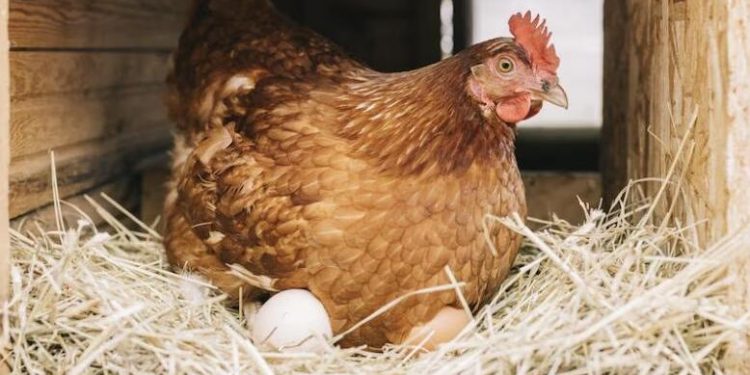Over the last 20 years, chickens have become increasingly popular as pets in both suburban and urban areas. Historically, the domestic chicken is believed to have descended from the red jungle fowl in southern China and Indonesia. Today, there are hundreds of chicken breeds around the world. Some are primarily kept for egg or meat production, while others, like the Silkie chicken, are kept as pets for their dog-like personalities and unusual appearance.
More recently, pet chickens have become even more popular, thanks to the increasing cost of store-bought eggs due to the outbreak of the bird flu (avian influenza) among commercial egg-producing chicken flocks.
Chickens can provide family companionship, fun, entertainment, sustainable fresh food, and plenty of poop that gardeners prize as a natural fertilizer/composting material. However, chickens are not legal everywhere, so before purchasing one, verify the laws of your state and town to ensure you are zoned to keep chickens and, if so, how many chickens you are allowed to keep. Chickens are social animals that like to hang out in groups. Ideally, flocks should contain at least three hens. For most backyard flocks, five or six chickens is an ideal flock size.
Also, different breeds of chickens have not only different appearances, but also different temperaments, disease resistances, and egg-laying abilities. Depending on the breed, eggs may be white, brown, blue, green, or even pink!
Before taking on a pet chicken, research the characteristics of different breeds so you end up with one that meets your needs and expectations.
Chicken Housing
Backyard chickens need to have a shelter (a coop) that provides adequate space, protection from the elements and predators, and good ventilation. A modified shed, barn, or stable with an outdoor run is a good option for a coop. You can also purchase ready-made coops or build your own.
Ideally, coops are slightly elevated off the ground to prevent flooding and have windows on each side, enough nest boxes to allow several chickens to nest simultaneously, outlets for lighting, fans if they’re needed, air inlets or ventilation holes on the roof, and a concrete floor treated with a pet-safe waterproof coating that allows for easy cleaning and drainage.
After chickens start to lay at about 20 weeks of age, they should be provided with one nest box, measuring 1 square foot for every 3–4 hens in the room’s darkest/quietest corner, raised off the floor, with bedding inside.
In addition to nest boxes, chickens should also have several perches in the coop that are elevated but not too far off the ground. Each bird should have a 12” long perch for roosting with a 14” separation between birds. Perches can be made from wooden dowels, branches, and boards.
Coops should be placed in a shaded area to prevent chickens from overheating. Chickens are most comfortable when environmental temperatures are between 65–75 degrees Farenheit. During extreme temperatures (close to freezing or during excessive heat waves), chickens should be housed inside.
Minimum flooring space requirements per bird in coops:
- Adult chickens (eight weeks old and up): 2.5–3 square feet of indoor space plus 5–10 square feet of outdoor space
- Chicks (up to 2 weeks of age): 10 inches square
- Juveniles (2 to 8 weeks of age): 1 foot square
In addition to indoor coop space, chickens also need an outdoor pen or “run” attached to the coop for exercising and foraging. Runs should be completely enclosed with a ¾” wire mesh fence that is at least six feet high and is buried at least 6” underground to prevent predators like raccoons, foxes, dogs, and birds from climbing over it or digging under it.
When overcrowded, chickens will create a “pecking order” or hierarchy within a flock. In this scenario, dominant birds peck on submissive birds, potentially leading to injury and death. In this case, more space must be provided, and birds may need to be separated if increased space doesn’t remedy the problem.
Coop Lighting
Whenever possible, chickens should be allowed outside to be exposed to natural sunlight. Being outdoors not only allows exposure to natural light cycles that drive normal egg-laying behaviors in chickens, but also provides ultraviolet (UV) light exposure to ensure chickens make vitamin D in their skin to absorb dietary calcium. Adequate dietary calcium is critical to laying healthy eggs.
Chickens that are unable to go outside due to inclement weather should be provided with full-spectrum artificial UV light indoors at an intensity of 5 lux. Lights that are too bright can cause aggression between birds.
When chicks are first born, they should receive 8 hours of artificial UV light exposure per day that is gradually increased by 30 minutes each week until they are 27 weeks of age. Artificial UV light helps ensure growing chicks make adequate vitamin D in their skin to ensure proper bone growth.
At around 27 weeks of age, chickens can be provided with a full 14–16 hours of artificial UV light exposure per day to help with egg production. Artificial UV light bulbs should be replaced every six months, as their potency wanes over time even though they still may look bright.
Coop Flooring and Bedding
Coops must have cement or other nonslip flooring to make them easy to clean and to prevent slipping, which commonly leads to foot and leg deformities. Age-appropriate bedding should be placed on top of the flooring. Young chicks should be housed on indoor/outdoor carpet with small amounts of pine or aspen wood shavings on top. Adults should be bedded on at least 8” of pine or aspen shavings or hemp bedding.
Cedar-based products should be avoided, as cedar contains aromatic oils that can irritate chickens’ respiratory tracts and make them more susceptible to infection. While hay, sand, and straw may be used as bedding to line nest boxes, these materials are non-absorbent and grow mold quickly when wet. These materials should not be used as floor bedding.
Coop Temperature
Heat lamps are necessary for young chicks who are not yet able to regulate their own body temperatures; these lamps should be positioned 20” above the bedding and in the center of the area chicks are housed. The temperature for chicks ages under 2 weeks of age should be maintained at 95°F. For chickens at 4-8 weeks of age, temperature should be maintained at 80°F. As chicks grow, the environmental temperature should be decreased by 5 degrees each week by moving the heat lamp 3 inches higher, away from the floor.
Adult chickens ideally should be kept at 70-75°F. Excessive heat in adults can cause decreased egg production, decreased appetite, stress, and even death. The coop must be insulated for the winter with heaters, if needed. In the summer, the coop should have good ventilation provided by fans.
Coop Cleaning
Coops should be spot-cleaned daily to remove droppings, soiled bedding, and uneaten food. Chickens should be removed before the coop is cleaned, and the coop’s electrical supply should be turned off.
Soiled bedding should completely removed and replaced at least once a month or more, depending on the number of chickens housed. To clean the coop, 1 teaspoon of bleach may be mixed with 0.5 gallons of hot water and used with a wire brush to scrub the coop free of dried debris. Commercially manufactured coop cleaners are available, as well. All traces of bleach or cleaner must be hosed out, and the coop should be fully dry before chickens are allowed back in.
Food for Chickens
Chickens need clean, fresh water and food every day. Feeders and waterers need to be washed in hot soapy water daily to keep them clean. Waterers and feeders specifically designed for chickens are ideal, but non-tippable bowls may be used, as well. Food and water dishes should be elevated a few inches off the ground to prevent birds from pooping in their food or water and falling in and drowning. Elevated feeders and waterers also keep insects and other pests from crawling into them. Waterers ideally should be refilled twice a day to keep water fresh and avoid dehydration. Feeders should be 3 inches in length per adult chicken, and waterers should be 0.75 inches long per adult chicken to prevent aggression and ensure each bird gets adequate nutrition.
Homemade diets commonly lack specific essential nutrients and are therefore not recommended for chickens. In contrast, commercially available, good quality feed (pellets and crumbles), appropriate for age/life-stage and nutritionally complete/balanced, should make up the basis of the flock’s diet and are critical for successful egg-laying. “Starter” feed is appropriate for chicks under six weeks of age, “grower” feed is for chicks between 6-16 weeks of age, and “layer” feed is for egg-laying hens aver 16 weeks. It is critical for pet parents to switch their chickens over to the appropriate, age-specific food as the birds grow and their nutritional demands change as they begin to lay eggs.
In addition to commercially available diets, chickens enjoy small amounts of vegetables and fruits, “scratch” (a mixture of whole grains such as barley, oats, and wheat, along with seeds and legumes), and occasional treats. Chickens allowed outside particularly enjoy foraging for untreated, fertilizer/pesticide-free grasses and plants, along with insects. Scratch, table scraps, and fresh greens (such as tomatoes, corn, spinach, and kale) also may be added to chickens’ diets to provide enrichment and opportunities to forage, but these items should make up <10% of their total diet to prevent nutrient deficiencies. Give treats only in the afternoon, after chickens have eaten their complete diet, and offer them no more than they can consume in 15-20 minutes.
While chickens enjoy small amounts of greens, avoid feeding fatty, sugary, spoiled foods, or foods toxic to poultry such as raw green potato peels, nightshade plants, raw beans, avocado skin and pits, alcohol, caffeine, and tobacco. Fresh greens not consumed after 10 hours should be removed before they spoil. Finally, when storing pellets or crumbles, store no more than two months of food at a time to prevent spoiling, and keep food in pest and rodent-proof containers.
Chicken Supplements
In addition to their regular diet, laying chickens should be provided with small amounts of crushed oyster shell grit (soluble/digestible calcium grit) to keep up with the demand for calcium to make healthy eggshells. Without adequate dietary calcium, chickens commonly lay shell-less or soft shelled, broken eggs. Oyster shell can be left out in a shallow dish for chickens to graze on, as needed. Chickens tend to consume only as much grit as they need, but in general, oyster shells should not make up more than 10% of their total daily diet. It should be offered only in the afternoon, after chickens have eaten their base diet of pellets or crumbles, and if they are over-consuming it, it can be removed after 15-20 minutes.
Egg-Laying
Most hens start laying eggs daily between 18–24 weeks of age and lay the greatest number eggs between 1–2 years of age, after which time egg-laying wanes. Collecting eggs as they are laid encourages further laying. As daylight gets shorter when winter approaches, chickens tend to lay fewer eggs. At 18 months of age, chickens go through a gradual molt of feathers over 2–4 months during which time they lay few to no eggs. After that, molting occurs annually.
Chicken’s Medical Needs
Pet parents should try to purchase chicks only from organizations that follow the National Poultry Improvement Program (NPIP). The NPIP is a voluntary program that encourages the implementation of new technology to improve the health of poultry and poultry products by establishing standards for the evaluation and testing of poultry breeding stock, baby chicks, poults (young poultry), and hatching eggs with the goal of reducing the incidence of certain diseases. Companies that follow NPIP standards typically have healthier birds, and pet parents should look only for companies that follow NPIP standards when purchasing chicks or chickens.
To minimize health problems, poultry flocks should have yearly examinations, blood and stool testing, and parasite control by a licensed, poultry-savvy veterinarian. In addition, all chickens should be vaccinated for Marek’s disease; this virus is contagious and fatal to chickens. Marek’s vaccinations are typically administered to birds while they are still in the egg, before hatching, or on the first day after hatching. Pet parents should add only Marek’s vaccinated birds to their flocks.
Other vaccines aren’t commonly administered to backyard flocks; these are more commonly used in poultry production facilities. However, vaccinations for other diseases, including fowl cholera, fowlpox, and coccidiosis, are all available through licensed veterinarians if your flock is diagnosed with any of these conditions.
Currently, commercial poultry flocks across the world are being infected with highly virulent avian influenza virus (HPAI). This virus is carried by wild birds that often show no signs of illness but that carry the disease to new areas when migrating. Affected poultry show signs of sudden death, decreased energy and appetite, incoordination, purple discoloration and/or swelling of various body parts, diarrhea, nasal discharge, coughing, sneezing, and reduced egg production and/or abnormal eggs. Pet parents who notice any of these signs in their birds should contact their veterinarian right away. In addition, backyard chickens should be isolated as much as possible from wild birds (including ducks, geese, hawks, and other raptors) to try to prevent spread of this disease.
In general, to minimize spread of HPAI and other deadly infectious diseases, poultry pet parents need to follow strict biosecurity measures for their flocks. This includes quarantining any new additions to a flock for a minimum of six weeks to monitor for signs of illness, providing disposable shoe covers and/or disinfectant foot baths for anyone having contact with a flock, changing clothes before entering poultry areas and before exiting the property, cleaning and disinfecting tools or other equipment before moving them on or off the property, and monitoring birds closely for signs of illness.
Signs of Illness
Some common signs of illness to watch out for in a chicken flock include:
- Decreased energy level/lethargy
- Fluffed feathers
- Delayed molting
- Abdominal swelling
- Changes in eggshell texture/thickness
- Decreased egg production
- Difficulty breathing
- Wounds
- Distended crop/delayed crop emptying
- Foot lesions
- Limping
- Diarrhea
- Sudden or unexplained death
If a bird shows any of these signs, it should isolated from other birds and should be seen by a veterinarian as soon as possible.
Chickens also can carry some diseases that are transmittable (zoonotic) to people, and people can, in turn, spread some diseases to chickens. For example, bacterial infections caused by salmonella, listeria, and E. coli may be spread between people and poultry, as can HPAI. To minimize spread of infection, wash your hands after interacting with chickens or their supplies, and be sure that anyone who is sick does not interact with chickens until they are well. Following the biosecurity measures outlined above will help minimize spread of disease not only between birds, but also between birds and people.
Chicken Handling
To build a bond with chicks and new chickens, pet parents should handle their new birds gently each day for a few minutes. To pick up adult chickens, do not chase them. Instead, train chickens to come to you by tempting them with pelleted food or treats. Once they’re approached you:
- Usher them into a corner and place your hand on the middle of their back, securing their wings under your fingers.
- Place your other hand under their lower body and gently lift them, hugging them close to your body.
- Do not let them flap or jump down, or they may hurt themselves.
- You can also hold them under your arm, like a football, to carry them long distances.
- Never pick up your chicken by its feet or neck, as this can be very traumatic and may cause mental stress and physical trauma.
- Always wash your hands after handling chickens, as they carry salmonella bacteria that is contagious to humans.
Chicken Enrichment
In addition to adequate shelter, food, and water, chickens must have psychological enrichment to maintain their physical and mental well-being. They enjoy different substrates to investigate and play in, including grass turf, peat moss, log tops, stone, and mulch. While chickens don’t bathe in water, they love to take dust baths to remove dirt, oil, and insects that may be trapped between their feathers. They should be offered a small shallow container or pile on the coop floor of clean sand, peat moss, or diatomaceous earth in which they can roll around. Dust bath containers should be removed and cleaned out daily to keep them fresh.
Chickens also can be provided with multiple perches and platforms for enrichment. Some chickens enjoy balls, mirrors, objects to peck at (like pinwheels), and other commercially available toys made for chickens. Pet parents can offer DIY pecking toys by hanging up heads of lettuce or broccoli or providing whole pumpkins for chickens to peck on.
Many chickens even enjoy music and watching television. Training your chickens to identify colors or patterns, walk on a leash, pick cards from a deck, play a tiny toy piano, or run through agility courses are all ways to bond with your chicken and provide them with a fulfilling and stimulating life.




















